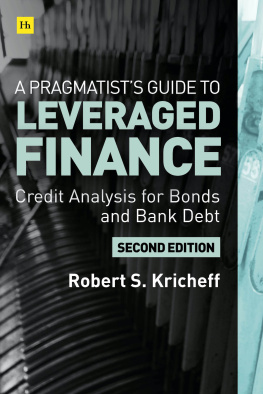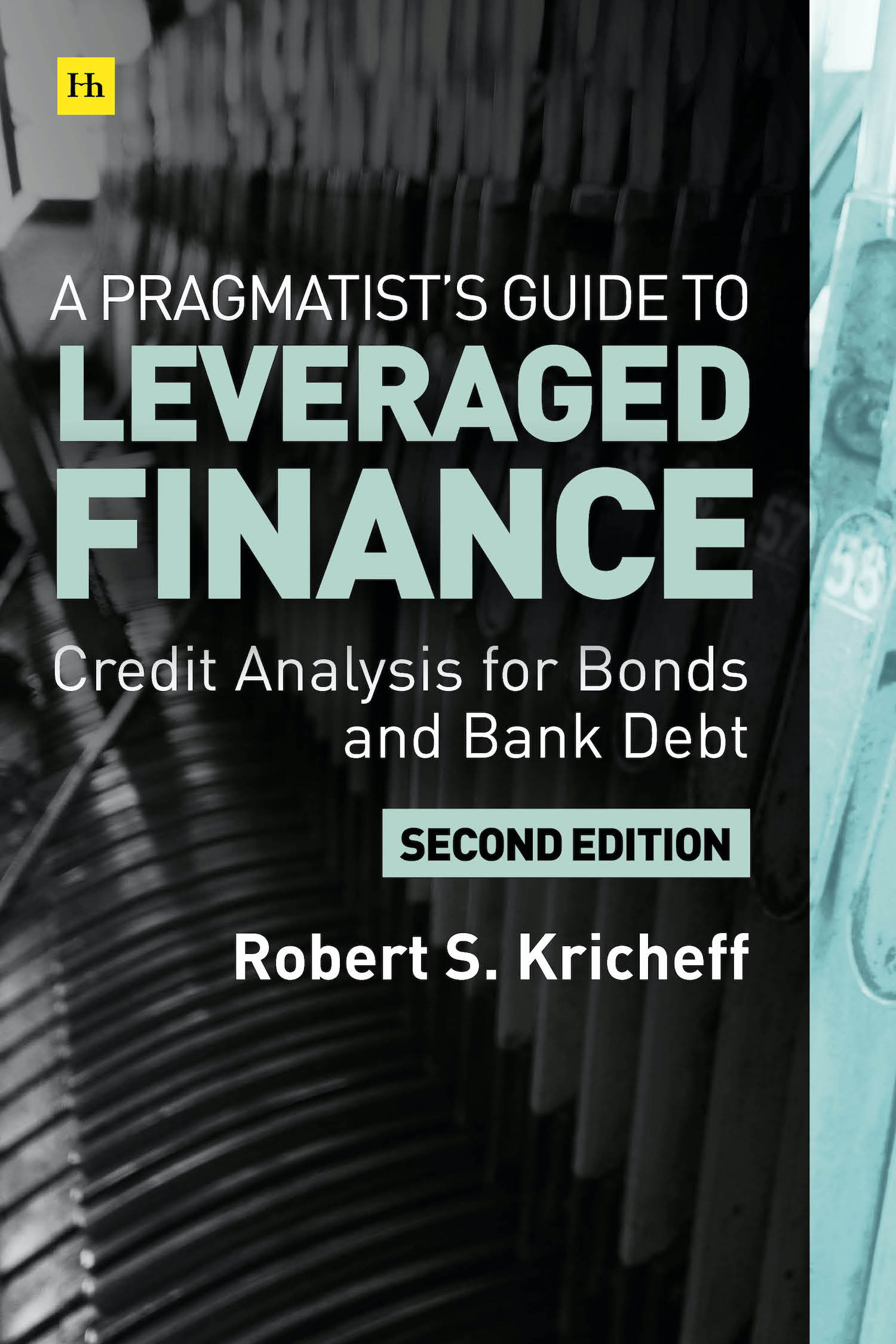A Pragmatists Guide to Leveraged Finance
Credit Analysis for Below-Investment-Grade Bonds and Loans
Second Edition
Robert S. Kricheff

Contents
To my parents, Marge and Irv Kricheff, whom I love. They are wonderful peoplegreat parents, grandparents and role models.
About the Author
Robert S. Kricheff is the global strategist and a principal and portfolio manager at Shenkman Capital, a $27 billion investment firm focused on credit. Prior to this he was a managing director at Credit Suisse for over twenty years, working in leveraged finance analysis on bonds, bank debt, and credit default swaps, and ran the Leveraged Finance Sector Strategy Group. At various times he oversaw emerging market and European bon d research.
Robert has lectured at New York University, University of London, and Columbia University, and at industry events such as the Milken Institute conferences. He has a BA in Economics and Journalism from New York University and an MSc in Financial Economics from SOAS University of London.
He has published three books and two ebooks on investment analysis, including Data Analytics for Corporate Debt Markets , A Pragmatists Guide to Leveraged Finance , and That Doesnt W ork Anymore .
Acknowledgments
I would like to thank everyone I have worked with in my career thus far, including all the clients, issuers and counterparties I have been fortunate to interact withI have learned from a ll of them.
I would specifically like to acknowledge John T. Lutz of McDermott Will & Emery LLP in New York City for his advice on this project and others, his exceptional legal guidance, friendship and great sense of humor (yes, in a lawyer). I would also like to thank his partner Nathan Coco at McDermott Will & Emery LLP in Houston for taking the time to review the section on bankruptcy and restructuring; his expertise added considerable value to th is section.
A thank you to Mark R. Shenkman, President & Founder of Shenkman Capital, and Justin Slatky, Chief Investment Officer of Shenkman Capital, for the opportunity to work at a dynamic firm and for all the time spent sharing ideas. Another thanks to our partner David Lerner for reviewing the section on CLOs and adding many insights that I used in the sections on bank loans.
I am grateful for so many things my Mom has done for me, and that exceptionally long list includes reviewing the earlier edition of this book and preparing notes on how to improve the editori al content.
Finally, I want to acknowledge John Kolmer, a great person and boss, whom I still tell st ories about.
Introduction
Whats in t his chapter:
- defining the market
- how companies enter the market
- unique aspects of leveraged finance credit analysis
- the book
T he global high yield leveraged bond and loan market is several trillion dollars. The market includes financings issued by corporations across a huge swath of industries and issuers from North America, Europe, Asia, and South America, as well as both developed and emerging markets. Debt is issued in multiple currencies and includes both public and private debt markets. It is one of the most unique and vibrant investment segments in the world.
There are numerous careers that interact with these markets, including managing money, selling, or trading at a broker-dealer, investment banking, private equity (PE), research analysis, and capital markets, or advisory roles such as investment consultant or lawyer. For all of these roles that interact with the leveraged debt markets, the basic skills of credit analysis are key to operating effectively and understanding these markets. The skills are also applicable to direct/private lending and exceptionally valuable for those operating in the equ ity markets.
Defining the Market
The leveraged finance market is generally defined by credit quality. The companies that issue debt in these markets are typically rated by the major credit agencies as below investment grade. Below investment grade is typically defined as below a BBB or Baa3 rating. The market encompasses a wide spectrum of credit risk, from fairly stable BB-rated securities that are close to investment grade all the way down to those in bankruptcy.
Although leveraged loans and bonds have been issued in several currencies, including US dollars, Canadian dollars, British sterling, and Euros, the issuers are still predominantly based in the USA. But the Eurozone and emerging markets are growing quickly. This book primarily uses examples from the US dol lar markets.
How Companies Enter the Market
Many companies issue debt that is initially rated below investment grade by the major agencies. In many cases, the funding was raised for expansion or acquisition that added leverage to a company. In some cases, the debt was part of start-up funding. Leveraged buyouts are another common way in which an issuer comes to the leveraged debt market. Usually, this is where PE firms, or individual investors, add debt to buy out a company.
Sometimes, developmental companies issue in the debt markets. These are fairly early-stage companies and because of limited cash flow generation, their debt is rated below investment grade. This type of funding was key for the development of the cable and satellite television industries and the mobile telephone industry. Many of these companies got most of their early funding through the leveraged finance market and probably would not have developed as quickly without financial innovations in this market. New casinos and energy facilities have also come to this market to be financed as start-ups, as well as new economy companies in the arena of ride sharing and ele ctric cars.
There are also companies that originally issued debt in another market that become part of the leveraged debt markets. These are known as fallen angels. These companies were investment-grade debt issuers, but as operations weakened or some specific event occurred, they were downgraded and became part of the leveraged market. This happened to General Motors for a period of time, and during the Covid-19 pandemic, to Ford. The existence of the leveraged finance market allows these fallen angels to still have access to public and private financing and gives first-time issuers the flexibility to finance grow th projects.
Companies ability to access funding in the leveraged finance markets can be a key to survival and can lead to great cash flow growth and job creation. Many companies that have grown dramatically were greatly helped in this process by access to this source of deb t financing.
Unique Aspects of Leveraged Finance Credit Analysis
Ever since Michael Milken and his team at Drexel Burnham Lambert helped the modern high yield market evolve, it has been driven by innovation and events. Few companies in the high yield market are stagnant or stable. Some produce steady improvements as they evolve toward investment grade, and others go through transitions, evolving through new ventures or acquisitions. Still others may be for sale or are looking to refinance to return capital to shareholders. Some companies are struggling and may be slipping toward default and bankruptcy. It is unlikely that any below-investment-grade companies are in a state of equilibrium.
The leveraged debt market has many of the features of traditional investment-grade fixed income, and also has the event-driven volatility typically associated with equities. Furthermore, there are structural features within the securities and among the participants that are only seen in the leveraged debt market. For these reasons, the analysis involved in evaluating these investments is unique.








